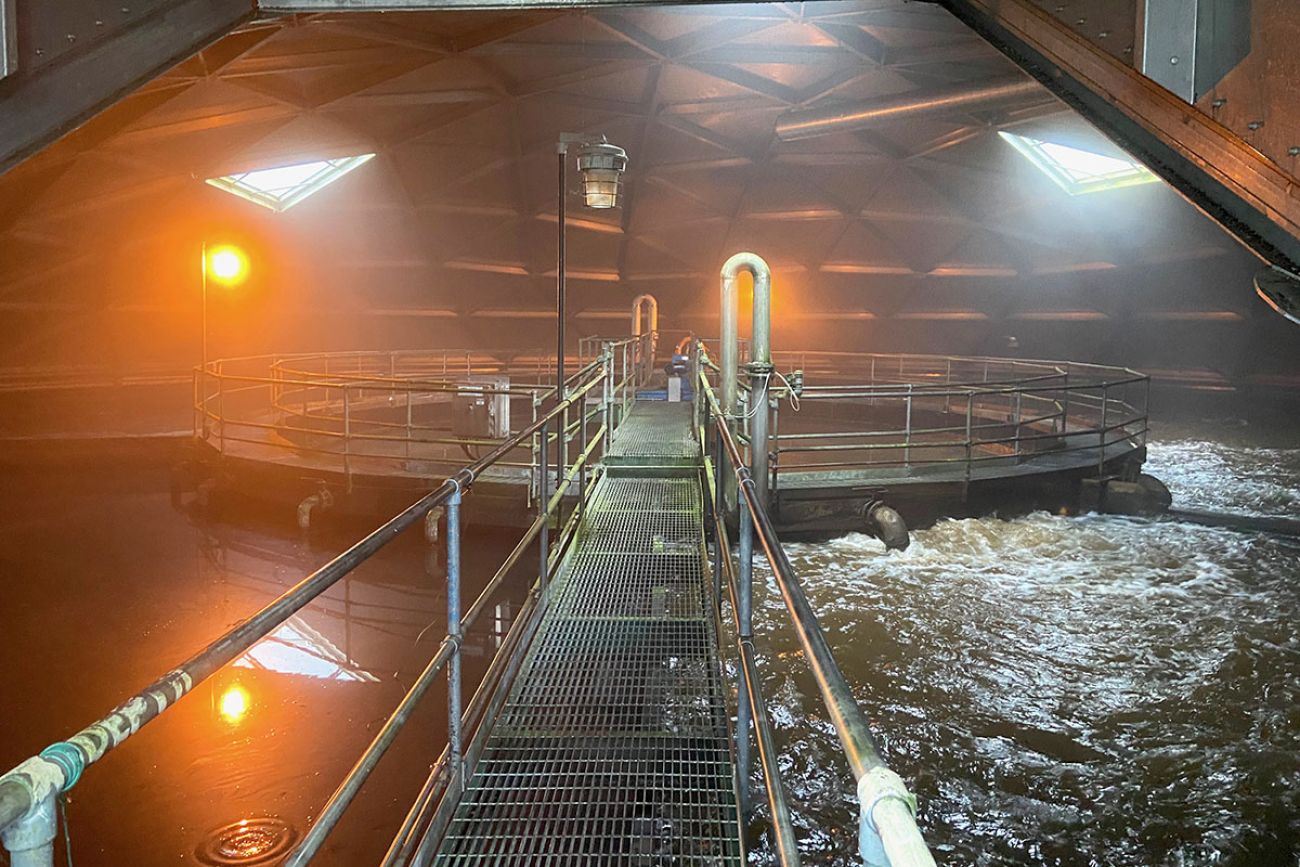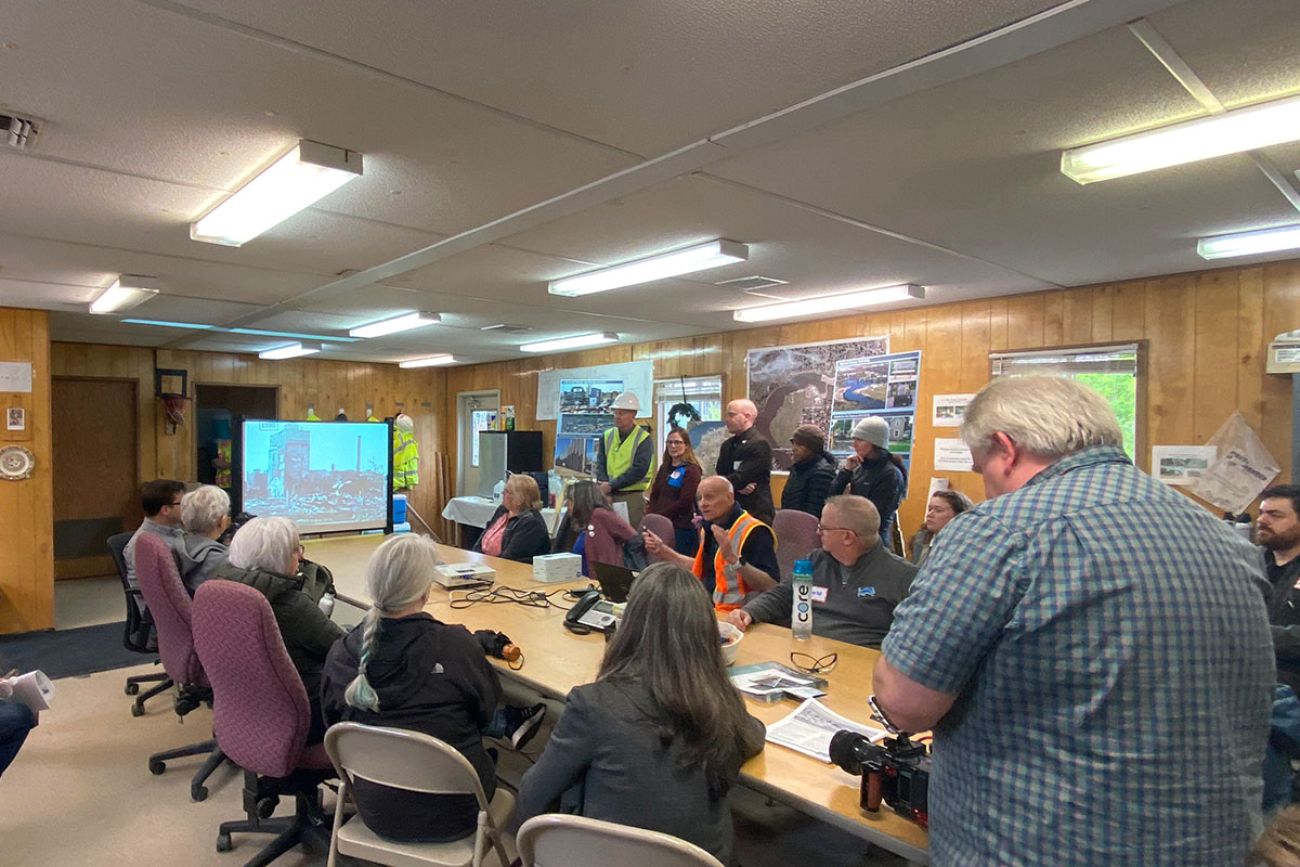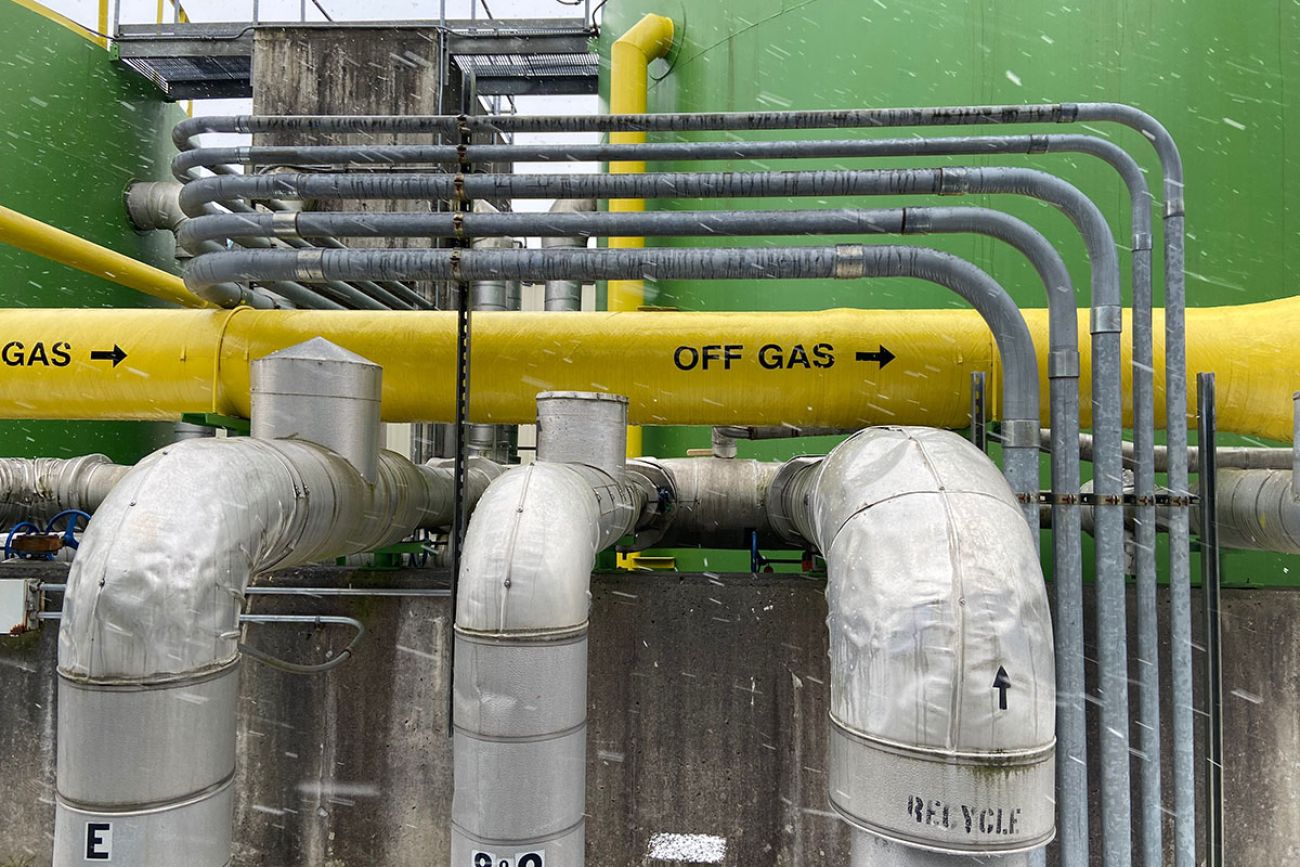As pollution costs grow, Lansing shows scant interest in speeding cleanups

- A cash-strapped state cleanup program has long struggled to address Michigan’s industrial pollution problems
- Now, long-term costs to manage severely contaminated sites are further straining the state cleanup budget
- Lawmakers have no plans to find new funding, meaning some dirty sites may fester for generations
DALTON—Tucked into the woods north of Muskegon, a hulking system of wells, pipes and tanks cleans as much water each day as some city water plants.
But this water isn’t for drinking. Instead, the treatment system has hummed along 24/7 for the past quarter-century, at a taxpayer cost of $2 million a year, to intercept cancer-causing chemicals left behind by a series of companies that once did business here.
It keeps a toxic stew of benzene, PCBs, arsenic and other chemicals from spreading through the groundwater into nearby Little Bear Creek, a Muskegon River tributary that was left so contaminated by the Ott Chemical Company and its successors, gases bubbled up from the creek bottom.
“There was nothing alive,” said Chuck Graff, a geologist with the Michigan Department of Environment, Great Lakes and Energy who works on the site. “The trees along the creek were killed. There were weird mats of algae floating on the bottom.”
Today the creek is in much better shape. But to achieve this, Michigan taxpayers have shelled out some $40 million so far, and will likely pay tens of millions more to treat the water for decades to come.
It joins a growing list of sites in Michigan where contamination can’t be easily scraped away or contained, forcing the public to underwrite expensive and sometimes lifetimes-long efforts to prevent its spread.
The expanding cost to steward these sites leaves the state’s already cash-strapped cleanup program with less money to start cleanups at thousands of other contaminated sites that fester across Michigan. At current rates of funding, it will take Michigan generations to remediate already-known pollution sites, while new ones are added to the list on a near-weekly basis.
Taxpayer-funded cleanups, by the numbers:
- $1.5 billion: How much state taxpayers have spent cleaning up toxic sites
- $970 million: How much federal taxpayers have spent cleaning up Michigan sites
- 26,000: The number of known contaminated sites in Michigan, which grows near-weekly as new hot spots come to light
- 50: Percentage of sites that are “orphans” where taxpayers will inherit cleanup costs
- 7,000: The number of so-called orphan sites where cleanup work has yet to begin
- $137 million: What taxpayers have spent so far at Michigan factory sites abandoned by General Motors, many of which still sit vacant today while the automaker uses public money to build its new plants elsewhere
Yet as lawmakers consider reforming Michigan laws to prevent contamination in the future, they are not considering ways to speed up cleanups at the 13,000-and-counting “orphan sites,” that already plague the state. At those sites, the company that caused the pollution has closed or otherwise escaped liability, leaving the public with a mess that can threaten public health and the environment, drag down property values and hinder local economies.
Related:
- As automakers win incentives for EV plants, Michigan pays for polluted past
- Michigan ‘polluter pay’ bills coming, following Bridge auto industry probe
- Wolverine Worldwide faces tough times selling shoes. Then came more PFAS
- 5 fixes for Michigan's polluted industrial legacy, and a cleaner future
“If we actually want to deal with these sites,” said Sean McBrearty, state director for the environmental group Clean Water Action, “we need revenue increases. We’re not going to be able to do it with the small pot of revenue we have now.”
Purple soil and public costs
A series of organic chemical-makers operated at the eponymous Ott/Story/Cordova site between the 1950s and 80s, where they dumped the byproducts of pharmaceuticals, dyes, herbicides and pesticides into unlined lagoons or stockpiled them in drums that later leaked.
In the sandy soil near Lake Michigan, the toxic waste “would just sink right in,” said Graff, polluting the aquifer that feeds Little Bear Creek. Business closures, mergers and bankruptcies left the government unable to recoup most cleanup costs from Ott, Story, Cordova or various parent corporations.

Instead, the U.S. Environmental Protection Agency took over, removing 10,000 drums and digging out thousands of tons of soil, much of it stained bright purple from chemical dyes.
But a full cleanup was infeasible. Chemicals had fused to the clay and silt beneath the aquifer, and were slowly bleeding back out, so the EPA built the pump-and-treat system that still operates today.
Under federal Superfund law, the federal government pays the bulk of active cleanup costs, but states eventually inherit responsibility for sites that need long-term care. By 2011, the treatment system became Michigan’s responsibility. Numbers provided by EGLE show that state taxpayers have so far dedicated $40 million to the Ott site.
It could be 50 to 100 years before the groundwater will be clean enough to stop treating it, said Josh Mosher, assistant director of the EGLE’s Remediation and Redevelopment Division.
State expenditures already going up
The Ott site reflects a vexing reality for Michigan cleanup managers, who have long lacked the staff and funding to keep up as Michigan uncovers more contamination left behind by chemical companies, automakers, paper mills and dry cleaners, sometimes decades ago.
Each new cleanup project has the potential to become a decades-long financial obligation like Ott, but the cleanup program’s budget is too small to both steward those sites, and keep pace as new contamination is discovered elsewhere.
The state now spends 10 to 15 percent of its cleanup budget stewarding sites with long-term needs, Mosher said, and that portion is on track to keep growing. As it does, he said, “it’s going to decrease our ability to tackle new stuff.”
The total statewide cleanup budget has averaged $61.3 million annually over the past five years, though it grew to $174.6 million this year largely with one-time dollars. It’s enough to work on a few hundred sites out of the 13,000 on the state’s docket — a pace at which it will take generations to get through the list.
Michigan’s cleanup funds are due to be stretched even thinner in the coming years, when the state inherits caretaking duties at the infamous, 1970’s-era Velsicol Superfund site in St. Louis, south of Mt. Pleasant.
There, the federal and state governments have spent more than $224 million removing contamination caused by Michigan Chemical Corp. and its parent company Velsicol, the entities behind Michigan’s PBB-tainted milk scandal and widespread pollution around their St. Louis factory site.

Like the Ott site, it’s impossible to dig up or destroy all that Velsicol left behind, meaning Michigan will inherit a long-term care bill of about $5 million annually, said Macy Pressley, an EPA spokesperson.
Other Superfund sites soon to be inherited by Michigan include the Ten-Mile Drain site in St. Clair Shores, with a cost of $250,000 annually, the Charlevoix Municipal Well site, at $300,000 annually, and the Tar Lake site in Mancelona Township, at $164,000 annually.
No new money to speed cleanups
A recent Bridge Michigan report detailed how Michigan’s weak pollution prevention and cleanup laws allow private companies to pollute the state with impunity, leaving the public holding the bill.
Yet Michigan lawmakers have never adequately funded state cleanup programs, so contamination festers across the state, threatening people, the environment and the economy in the process.
The community surrounding the former Ott/Story/Cordova factory earned the nickname “Dirty Dalton” because of the shadow cast by contamination, said Township Supervisor Jeff Martin. Only now, after decades of cleanup work, is some semblance of commerce returning to the Ott site: Businesses will soon begin storing excavators and other heavy equipment there.

Communities contending with orphan sites, Martin said, experience “a compounding economic handicap.”
The properties become virtually valueless, the stigma associated with them permeates through the community and the money spent to clean them eats into budgets for other priorities, like road-paving, that make communities attractive to businesses and residents.
But the slow action to clean up Michigan’s thousands of other dirty sites doesn’t appear likely to change anytime soon.
The Michigan legislature is poised to consider a suite of bills to better regulate industrial contamination in Michigan and prevent companies from pushing cleanup costs onto taxpayers. But missing from the package is any new funding for orphan sites.
Michigan’s industrial legacy
The latest on pollution in Michigan:
- Michigan ‘polluter pay’ bills coming, following Bridge auto industry probe
- Did auto industry pollute your Michigan town? Find out with interactive map
- Photos: See how auto companies left trail of pollution, toxins in Michigan
Repeating history:
- As automakers win incentives for EV plants, Michigan pays for polluted past
- ‘They destroyed our little town.’ What Michigan’s auto industry left behind
- With thousands of tainted sites, Michigan Dems eye return to ‘polluter pay’
- Key findings in Bridge Michigan auto project
The cost of bad policy:
- How Bridge tallied $259M in public costs for auto industry pollution
- Small supplier, big mess: Jackson pays the price of auto industry pollution
A new road:
Spokespeople for Republican House and Senate leaders did not grant Bridge’s request for an interview on the topic of contaminated site funding and oversight. But historically, Republicans have opposed proposals to strengthen state cleanup laws.
Sen. Jeff Irwin, D-Ann Arbor and an architect of the proposed reforms, said he had considered including a bill in the package that would fund cleanups with a tax or fee on pollution-prone industries or chemicals. That’s how the federal Superfund program works, and Michigan uses a similar mechanism to clean up leaky gas station fuel tanks.
But Irwin said he backed off because he predicted the bill would fail in a politically-divided legislature where business lobbyists often get their way.
“Anytime you try to pass something in Lansing that is going to ruffle the feathers of the corporate interests, it’s going to be very difficult to get votes” from either party, he said.
Environmental advocates also blame the influence of money in politics. Forcing polluters to pay for cleanups polls well with voters, McBrearty said. But industries that oppose so-called “polluter pay” reforms have the money to donate to political campaigns and hire lobbyists to advocate for their interests.
“There are core issues that we need to fix with our democracy before we get to the point where we can have those conversations (about making industry pay for cleanups),” McBrearty said.
The Michigan Chemistry Council, which represents the chemicals industry, would not comment on whether it would support an industry-funded mechanism for cleaning up orphan sites. Executive Director Jami Des Chenes stressed that chemical manufacturers have come a long way since the days of Ott, “and we support holding bad actors responsible.”
“We want to participate in discussions to ensure best practices but will look to support policies that are rooted in science and provide a clear path forward to achieving results,” Des Chenes said.
Representatives of the Michigan Chamber of Commerce, the state’s largest business lobby, have previously said they’re open to discussing funding options for orphan sites, but their support would depend on how much costs businesses would be expected to shoulder.
With seemingly little appetite to take up the conversation anytime soon in Lansing, Irwin said he’s hopeful that Michigan can at least keep the orphan site list from growing.
In addition to boosting transparency around contaminated sites and raising the bar for cleanups, the bill package he co-sponsored in October would require industry to post bonds or carry insurance covering the possibility of a toxic spill, so taxpayers are less likely to pick up the tab when companies go bankrupt.
“It’s not going to dig us out of the hole we’re in,” Irwin said, “But it helps us avoid making the hole bigger.”
Those reform efforts, too, are likely to be controversial. Industry groups have signaled opposition, arguing policies that make it more expensive to do business in Michigan would discourage economic growth.
In Dalton, Martin said he understands that perspective. But decades of experience with the contaminated sites in his small community have taught him, “it’s also a huge economic hindrance if you contaminate the water supply.”
Michigan Environment Watch
Michigan Environment Watch examines how public policy, industry, and other factors interact with the state’s trove of natural resources.
- See full coverage
- Subscribe
- Share tips and questions with Bridge environment reporter Kelly House
Michigan Environment Watch is made possible by generous financial support from:
Our generous Environment Watch underwriters encourage Bridge Michigan readers to also support civic journalism by becoming Bridge members. Please consider joining today.
See what new members are saying about why they donated to Bridge Michigan:
- “In order for this information to be accurate and unbiased it must be underwritten by its readers, not by special interests.” - Larry S.
- “Not many other media sources report on the topics Bridge does.” - Susan B.
- “Your journalism is outstanding and rare these days.” - Mark S.
If you want to ensure the future of nonpartisan, nonprofit Michigan journalism, please become a member today. You, too, will be asked why you donated and maybe we'll feature your quote next time!






